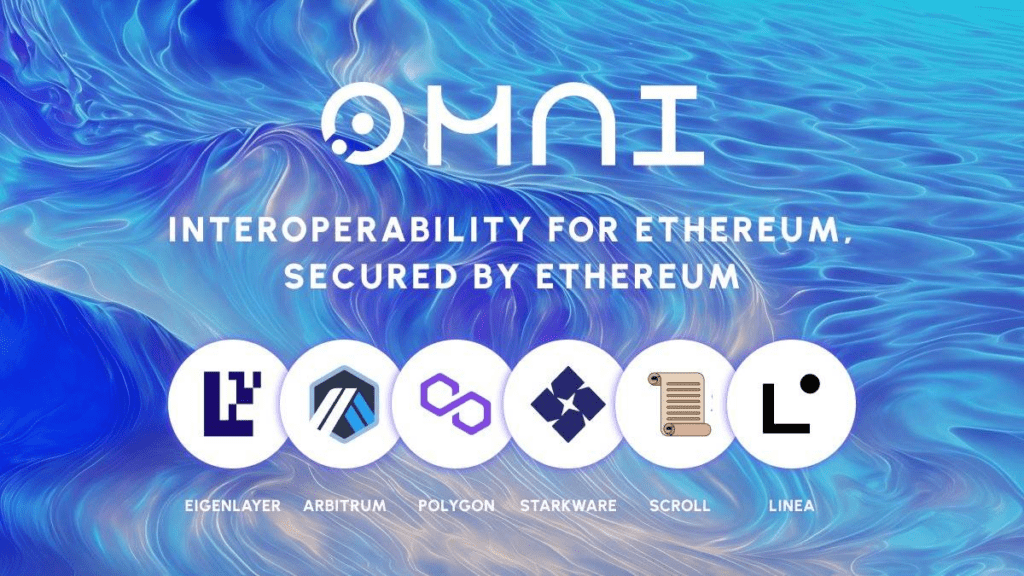This is based on the fact that the scaling solutions, also known as Rollups, help current Ethereum Layer 2 solve the Ethereum scalability problem, but were unable to perform the same interactions between different Rollups, leading to fragmented liquidity . Fragmentation in different L2 networks greatly reduces the user experience and makes Ethereum more fragmented than ever.
What is Omni Network?

Omni Network is a protocol that provides an EVM-compliant infrastructure layer by using EigenLayer to facilitate the connection of Layer 2 rollups such as Optimism, Arbitrum, zkSync, and Starkware… more quickly.
Integrating the Ethereum EigenLayer re-commit protocol and the Cosmos SDK into a unified platform brings together Ethereum’s modular ecosystem. It allows developers to build on all Layer 2 on Ethereum to achieve ETH security.
By combining the security of Ethereum with the speed and programmability of Cosmos in this way, developers can reach more users and users themselves can more easily access innovative new applications. Therefore, the project helps developers build and scale their applications while ensuring security without fragmenting liquidity.
This new design space is believed to usher in a new era of modular blockchain. As leaders in this trend, the project says it will open source its modules to accelerate adoption and testing of these technologies by other groups looking to build modular blockchains – their own dedicated and secure kettle.
Problem

For more than a decade, the crypto industry has been criticized for the slow and expensive nature of layer 1 blockchains. In recent years, scaling solutions, also known as rollups, have begun to offer users the same open, permissionless promise of blockchains at a low cost. The problem, however, is that too many aggregations only grow when a few high-profile zkEVMs start rolling out their mainnet.
While the intent to build these synthetic solutions is pure, Ethereum is more broken than ever. As a result, both users and their liquidity, which used to have common ground on Ethereum layer 1, were scattered across several isolated environments. The problem of high transaction costs has thus been solved, but it is certainly at the expense of fragmentation.
In the current context, developers who want to build dApps have only two options:
Option 1: Choose an independent ecosystem
With this option, developers deploy their applications on a single chain. However, users will need to use bridges to move assets across chains. This reduces the number of users and causes certain problems for new users.
Option 2: Multiple chains
Developers can choose to develop their applications using data transfer protocols to communicate between smart contracts on different chains. The complexity of this design model makes it easy for protocols to expose security vulnerabilities.
Both options pose certain problems for projects. Omni Network recognizes that problem and introduces a blockchain capable of interoperability and application management across all different chains. This solution helps access liquidity and users in any ecosystem.
Loosen the knot
Interoperability guaranteed by Ethereum
Nearly half of the money lost in DeFi hacks comes from vulnerabilities in interoperability protocols. The design space needs to be improved, leading to fragile, insecure implementations. Omni solves this problem by reimagining the future of the decentralized economy.
The future of cryptocurrency is built with Ethereum at its core. With this in mind, Omni built the most secure interoperability solution ever invented. By using EigenLayer, the Omni Network can enable fast and rooted, low-cost communication between aggregations with security in Ethereum itself.
The Omni Network includes validators running both an Ethereum node and a built-in Rollup node, through which validators reset ETH and validate Rollup status updates to facilitate global interoperability.
Omni sets a new standard for cross-modular blockchain security. Using a reset stake mechanism, the Omni Network is the first blockchain to have fully customizable features while still receiving security from Ethereum.
Programmable interoperability
Omni is not only the most secure interaction solution ever made, but also the most functional. By building a programmable interoperability layer, Omni will provide economically advantageous cross-rollup applications through features such as multi-rollup liquidity pooling, compared to specified applications deployed on different networks.
Omni’s execution layer is EVM-compatible, implemented by Ethermint (an EVM module) on Cosmos, allowing developers to use their trusted Solidity tools for development. The execution layer includes a built-in functionality to access status, notifications and applications from Total Integration, creating a seamless user access and liquidity experience.
By building a programmable interoperability layer, Omni enables developers to create globally applicable applications by default, reducing the complexity of their operations. developers.
Programmable interoperability will provide umbrella applications with a fundamental economic advantage over individual applications through features such as multiple liquidity pooling.
The Future of Omni Network

Omni Network announced on April 26 this year that it has completed an $18 million funding round. Pantera Capital, Two Sigma Ventures, Jump Crypto, Hashed, The Spartan Group and more participated in this funding round. Omni claims its core technology partners include EigenLayer, the Ethereum re-commit protocol, and Arbitrum, Polygon, StarkWare, Scroll, Linea, and more, the Ethereum Layer 2 scaling network.
Omni will launch the Omni Network public testnet in Q3 of 2023 and plans to launch the first version of the mainnet in 2024 in collaboration with key Rollup partners such as Arbitrum, Polygon zkEVM, Scroll, ConsenSys’ Linea, and Starkware.
By taking security from ETH, Omni Network plans to reconnect the entire Ethereum ecosystem so that projects on Ethereum are no longer limited to a single Rollup, but users and liquidity can be found within the Ethereum as a whole ecosystem. The overall impact of this approach on Ethereum is to be expected.
Notably, the Omni Network will mine Eigenlayer, a protocol built on the Ethereum network that introduces the reset of authorized Ethers on the beacon chain and of liquidity deployment schemes such as Lido Finance. With EigenLayer, Ethereum stakers can help secure multiple decentralized finance protocols by resetting their deployed Ether and opting for multiple DeFi projects at the same time, providing pooled security.
While Omni Network has not yet launched a test network, it is aiming to provide a seamless and secure Rollup user experience by modularizing the application’s core infrastructure, which has attracted a lot of attention.
The Omni Network is still in the early stages of development and there are still many things to release to the public. In the coming weeks, the Omni Network team announced that they will be releasing more details on how DeFi developers can take advantage of the newly launched layer two interoperable infrastructure.
Specifically, the Omni Network aims to educate users on how it is deriving security from Ethereum for interoperability, a new layer of programmable interoperability applications that will facilitate, and technical advancements with its major aggregation partners.
DISCLAIMER: The information on this website is provided as general market commentary and does not constitute investment advice. We recommend that you do your own research before investing.

